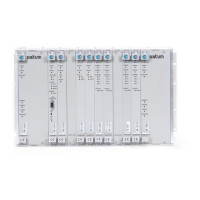TL1 Command Interface
302 SSU-2000 User’s Guide 12713020-002-2 Revision D – April 2004
RTRV-STATUS-LRM:[tid]:[aid]:
ctag;
Valid aid code: ALL, SxA[y[-z]]
This command returns the condition (current operating mode
and status) of an LRM module or port. The format of
response messages are:
^^^"aid:mstat,clksrc,ctaid" <cr lf>
^^^"aid:pstat,frame,los,ais,lof,bpv,slip,
slipcount,los_side2" <cr lf>
Line 1 contains:
aid = module or port
mstat = {ENA|DIS} where ENA indicates the module is
enabled, and DIS indicates the module is disabled
clksrc indicates which clock {A|B|C|D|NONE} is the
reference
ctaid indicates if the CTA is installed or not
{NONE|DUAL|QUAD} where NONE indicates there is no
CTA installed, DUAL indicates Dual (2 Port) CTA
installed, and QUAD indicates Quad (4 Port) CTA
installed.
Line 2 contains:
aid = module or port
pstat = {OK|CUT|DIS} for port status where OK
indicates this port is enabled and functioning correctly,
CUT indicates that this port is in cut-through mode, and
DIS indicates that this port is disabled and not in
cut-through mode.
frame = {D4|ESF|NONE}
los, ais, lof, bpv, and slip are the current second error
condition {F|OK} where F indicates an error has occurred
slipcount indicates the slips in a 24 hours period
los_side2 (the LOS of Side 2) is {F|OK} where F
indicates an error occurred.
RTRV-STATUS-NTP:[tid]::ctag;
Valid aid code: None
This command returns the current network timing protocol
status for the unit. The format of the response message is:
^^^ip1,offset,delay,dispersion"<cr lf>
^^^ip2,offset,delay,dispersion"<cr lf>
^^^ip3,offset,delay,dispersion"<cr lf>
where:
ip = the server IP address used by the client or
broadcast client or broadcast server
offset = the number of seconds (partial seconds) that
the local time was adjusted by
delay = the calculated delay in the communication path
dispersion = a value that indicates the accuracy of the
offset/delay settings. There can up to three NTP IP
addresses listed
Table B-5. TL1 Retrieve Commands (Continued)
Command Description

